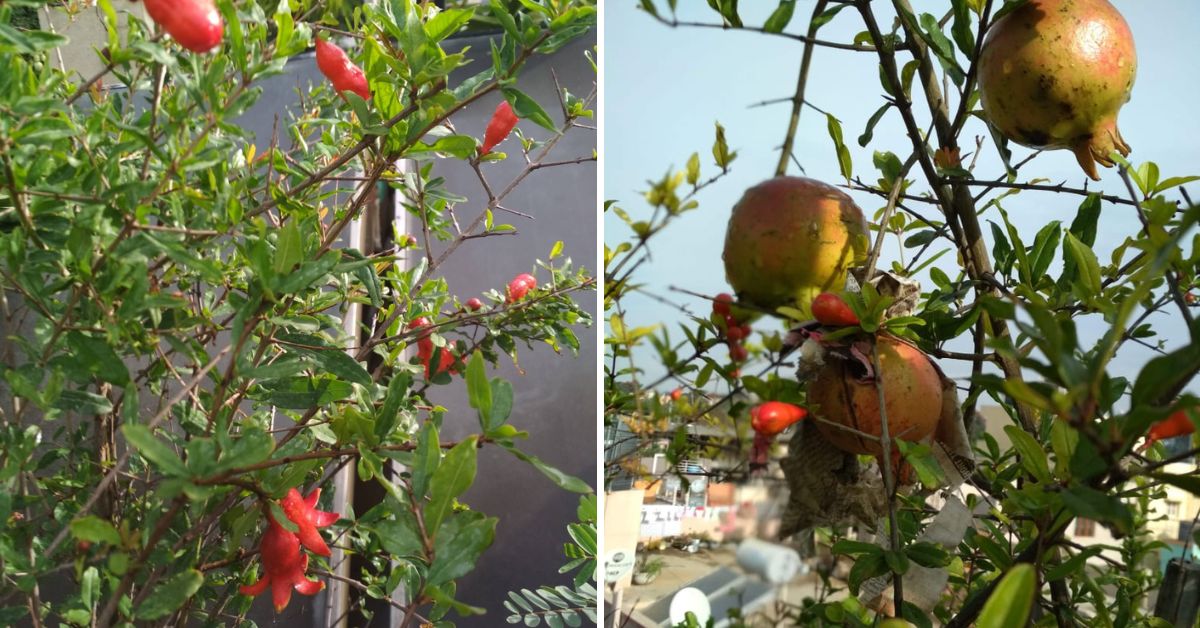How to Grow Pomegranate in Pots at Home: Gardener Shares 8 Easy Tips
Want to grow pomegranates at home but have limited space? Bengaluru-based Lizy John, an urban gardener, shares eight easy tips for how you can do it.

With tough leathery rinds and a jewel-studded interior packed with juicy arils, pomegranates are among the most unique fruits.
Belonging to the family Lythraceae, these are not only delicious, but nutritious as well. They are also a rich source of antioxidants and are high in fibre, vitamins, and minerals.
Though the fruit is equally tasty and healthy, it is often considered a difficult task to nurture pomegranate trees to bear healthy fruits. These fruit trees, with glossy leaves and scarlet red, tube-shaped flowers, grow well mostly in sunny and warm locations.
According to Lizy John, a Bengaluru-based urban gardening expert, pomegranate trees are easy-to-grow in Indian climate and require less maintenance than several other fruit-bearing plants or trees.
“The best thing about pomegranates is that they can be maintained either as a small bush or as a tree. But for people with smaller spaces, like me, the best way to nurture them is in pots on the terrace, or anywhere with ample amount of sunlight,” Lizy tells The Better India.
Lizy has been growing over 100 varieties of fruit trees and vegetables organically on her terrace for the past nine years. She says, “With a little care and patience, we can grow anything on our own at home. Such fruits and vegetables taste much better than the ones we buy from the market.”

She shares a few steps and tips to keep in mind while planting and nurturing a pomegranate tree at home.
- Plant a healthy sapling
It is better to propagate pomegranates for the first time through a sapling than sowing seeds, as it would take a lot of time for the seeds to grow into a fruit-bearing tree. Therefore, it is advised to buy healthy saplings from a local nursery.
- Well-draining pot or drum
While planting the sapling in a pot or drum, it is important to make sure that the vessel drains well. Lizy suggests using a big plastic bucket or drum to plant fruit trees. “Since they are fruit trees, they need more space for their roots. Therefore, it is always better to plant them in a large pot to avoid repotting later,” she adds.
Also, make a few holes of around one inch at the bottom of the pot or drum to ensure water drainage. Before filling it with the soil mix, place a net inside the pot to cover the holes to avoid the blockage.
- Right potting mixture or soil
“I always treat my soil well before planting anything. For that, I mix a bucket of soil with a handful of lime and dry it,” says Lizy, who has been following this procedure for all her fruit trees and vegetables.
The soil treated with lime is then mixed with equal quantities of cocopeat, cow dung, and vermicompost or home compost (One bucket of soil requires half a bucket of each component). A handful of bone meal and neem cake can also be added to enrich the potting mixture.
- Layering the soil
First layer the bottom of the pot using dried leaves and then add a layer of the soil mix. Fill the pot up to three-quarters with at least three such alternate layers of dried leaves and potting mix. Keep the pot for at least a week and then plant the sapling.
- Requires ample sunlight
Pomegranates are warmth-loving plants, and hence, it is essential to find a suitable place in the garden or on the terrace where your crop will get abundant sunlight.
- Watering and fertilisers
After planting the sapling, water it once every day. In order to retain moisture in the soil, a layer of dried leaves or coconut husks can be placed on the surface.
Lizy also applies organic manure like home compost or cow dung once in a while.
“I have been following a technique for the past several years. Take a plastic bottle and cut open its bottom. Then, fix the open mouth into the soil in the pot. Fill the bottle with the daily kitchen waste, dried leaves, etc, and add some jaggery, buttermilk, or cow dung into it. Then close the bottom of the bottle using a coconut shell. The slurry formed inside the bottle will drip into the soil, nourishing the growth of the plant,” she explains, adding that this fertilising technique can be applied to any fruit tree.

In order to prevent flowers from falling before they become fruits, take two tablespoons of curd, one teaspoon of hing, and mix them in one litre of water. Spray onto the plants.
- Combating pests
In case of a pest attack, take a mix of 5 ml of neem oil, mix it in one litre of water, and add some soap or detergent. Then spray it onto the plant to keep the pests at bay. Another method is to ferment rice water, dilute it in water, and spray it onto the plant.
- Prune the plant as per growth
While maintaining a fruit tree in a pot or a drum in a small space, it is important to make sure that it grows up to a certain size or height. Therefore, it is essential to prune the top part of the plant when it grows up to 2-3 ft, which helps in better growth and fruiting.
“Usually in Bengaluru’s weather, the plant bears fruits within five or six months. After successfully growing a healthy and fruit-bearing tree, one can easily propagate new saplings through methods like air layering or cuttings,” adds Lizy.
Edited by Divya Sethu
This story made me
- 97
- 121
- 89
- 167
Tell Us More
We bring stories straight from the heart of India, to inspire millions and create a wave of impact. Our positive movement is growing bigger everyday, and we would love for you to join it.
Please contribute whatever you can, every little penny helps our team in bringing you more stories that support dreams and spread hope.



















